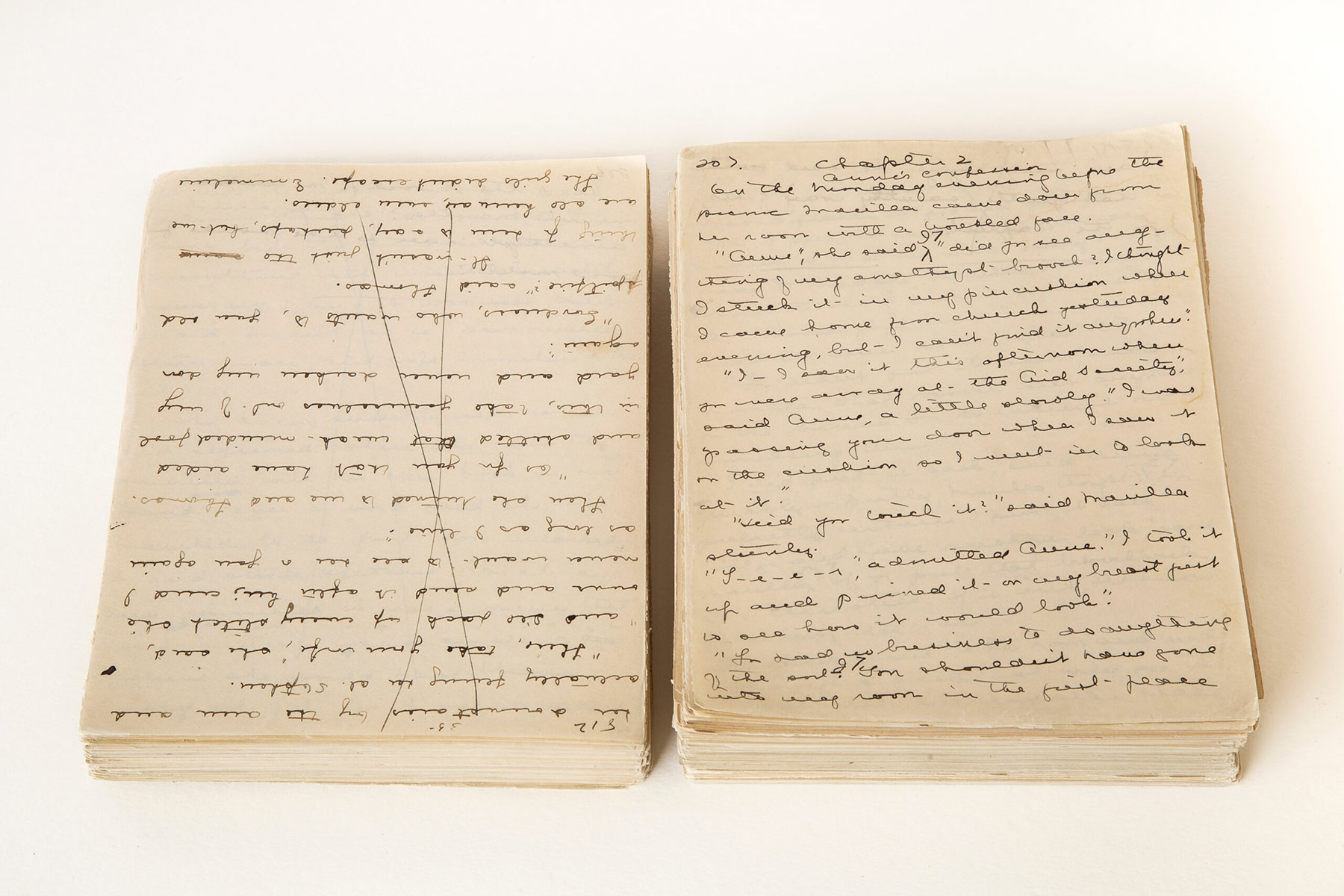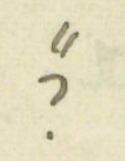About the Project
Emily Woster
The Manuscript Viewing Experience
Each manuscript page has been carefully scanned, transcribed, and annotated for inclusion in the exhibit. Transcription and annotations were done by Emily Woster and Elizabeth R. Epperly.
There are multiple options for viewing the annotations and navigating within the manuscript.

The annotations on each page include both Montgomery's additions to the manuscript (see the maroon LMM Notes) and a variety of other related material. Our Text, Video, Audio, and Photo Annotations explain unique aspects of the story or of Montgomery's life on Prince Edward Island. Every page of the manuscript contains at least one annotation or one of Montgomery's own notes.
To navigate, use the Prev Page and Next Page links at the top of each scanned image or use the dropdown menu on the right to move between chapters or sections of the novel.

The buttons at the bottom of each scan provide additional viewing options. Icons On/Off removes or replaces the icons on each scanned manuscript page. View Full Resolution Scan opens a high resolution image of the page in a new browsing tab.
These high-resolution images (see below) allow you to zoom in and out and move around each page with either your mouse, your keyboard, or a touchscreen. This viewer allows you to see nuances in Montgomery's handwriting and even the translucency of some of the pages.


About the Manuscript

The manuscript is housed in the collections of the Confederation Centre Art Gallery in Charlottetown, Prince Edward Island. Both sides of each page (recto and verso) were scanned at the Robertson Library's Digitization Lab at the University of Prince Edward Island.
The manuscript has been on display only a few times. A clipping in Montgomery's scrapbooks notes that the first page was once on display at a "Book Week Event" at the Royal York Hotel in Toronto sometime around 1935. Since then, some pages have even traveled to Japan for exhibits. The entire manuscript was brought to the launching of the L.M. Montgomery Institute in April of 1993, and various exhibits at the Confederation Centre have included the manuscript. However, even when the entire manuscript is on display, only one or two pages could be viewed at a time.
The full stack of pages (see above) includes a variety of paper types, some lined and some unlined, some regular sheets and some irregular. You can see that many of the pages have ragged edges, suggesting that they were torn from something like a notebook. The edge of the stack shows how the variety of paper types have all aged and yellowed differently.
The stack measures 6.6 cm (2.6 in) high, roughly 16.6 cm (6.5 in) wide, and ranges from 21.5 to 21.9 cm (8.4-8.6 in) in length, depending on the type of paper used in each section. On the right, you can see the stack next to an average smartphone for scale.
Approximately the last third of the stack above are Montgomery's "Notes" pages, where she recorded the alphanumeric additions generated while she revised.

Recto and Verso (Front and Back) Pages
The exhibit includes full scans of both sides of each sheet of paper. Below, you'll see the manuscript stack "opened" to show both the verso, or back, of one sheet on the left and the recto, or front side, of another sheet on the right. The verso pages of roughly the first third of the manuscript contain a variety of material from other short stories and poems. After that, the story of Anne of Green Gables continues front-to-back.

Notes and Annotations
Montgomery's own notes are highlighted on each manuscript page, just under our transcript, in a section for "LMM Notes." You'll see that her notes also contain internal edits and changes where she replaces words or adds details.
The Text, Video, Audio, and Photo Annotations include interesting notes and details about the creation of Anne of Green Gables or about Montgomery's life and times.
These additions are not meant to be exhaustive; rather, they should enrich your understanding of the novel and its creation. All annotations are original and many contain rarely- or never-before-seen media.
Each annotation will appear when the corresponding icon is clicked (below left) and each is also included at the bottom of each manuscript page (below right).



Notes on the Transcription
Montgomery's Handwriting
Montgomery's handwriting is notoriously difficult to read. She wrote in a somewhat cramped, slanted hand that left many letters bleeding into one another horizontally.

As you read, you will see that she tended to add the horizontal bar to each lowercase letter "t" a few spaces after the vertical stem of the letter. Her lowercase "y" and "g" are sometimes indistinguishable, and she often left punctuation outside or just underneath quotation marks.


Transcription
In transcribing the text of the manuscript, we have captured as much of Montgomery's original text as possible, including her sometimes inconsistently applied American and British spellings, capital letters, and commas. We have copied her subscript carets to indicate added material (see right), and transcribed where her punctuation is, to modern eyes, irregular.

For easier reading, we have used a hard return, or extra vertical space, rather than indented lines, to indicate the start of a new paragraph or passage.
Brackets are used sparingly, only indicating where there is missing material (from a tear in a page for example) or where a glaring error or omission on Montgomery's part may affect readability. In particular, we used a period within brackets [.] to indicate where she has left off end punctuation. We use [sic] only rarely to point out an error of Montgomery's that we have duplicated.
Montgomery used many hyphens and dashes throughout the text. Since the lengths of these hyphens and dashes are irregular in her handwriting, we have done our best to render them as spaced hyphens or em dashes accordingly. We have not transcribed hyphens that separate a word that breaks into the next line of text unless that word spans more than one sheet of the manuscript.
Our annotations indicate where there are interesting differences between this handwritten manuscript and the final, published edition of the novel. For fuller lists of these changes, see Anne of Green Gables: The Original Manuscript (2019), edited by Carolyn Strom Collins and the Norton Critical Edition of Anne of Green Gables (2007), edited by Mary Henley Rubio and Elizabeth Waterston.
Note on the Translation
Québec Amérique, one of the publishers of the French editions of Anne of Green Gables, gave us permission to use their published translation. Of course, the published book is a translation of the final version of Anne, not of the original manuscript. Therefore, for several reasons, we had to make many changes to the published version. The first reason was to make the French ‘transcription’ correspond to the matching page of the manuscript. Some sentences—even entire paragraphs—had to be rewritten in order to make the copy look like the manuscript. Another reason was to change certain wording to reflect the revisions Montgomery had made to her manuscript. Finally, the Annotations provided by the curator and by the contributing consultant shed new light on some of the sentences and paragraphs that had been originally translated. As an example, if one of the sentences came from the Bible, or a play by Shakespeare, the published French versions of these excerpts were used to replace the published translations.
In many instances—throughout the Annotations, and the informative text of the website—there are quotations from various publications. Montgomery’s journals are often quoted, as are her correspondence and various newspaper articles. These documents have never been translated, nor have some of the recitations and poems mentioned in the book. For ease of reading, it was decided not to use the common phrase [traduction libre] as it would have occurred too often.
Regarding struck out quotation marks in the English manuscript: since French uses dashes to mark the beginning of a line of dialogue rather than quotation marks wherever Montgomery struck out a quotation mark we used the following symbol: « »